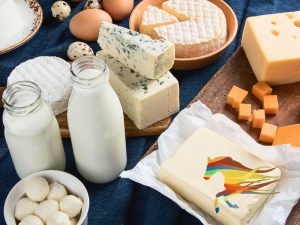

There are many farm diversification options for dairy farms, some of which involve completely new non-farming activities, but many involve simply selling your milk in a different way. This could be through new products such as cheese, yoghurt or ice cream, or through direct sales such as milk vending machines. However, when you are selling your milk/milk products, you will need to market them to your customers. This is where farm marketing comes into play.
through new products such as cheese, yoghurt or ice cream, or through direct sales such as milk vending machines. However, when you are selling your milk/milk products, you will need to market them to your customers. This is where farm marketing comes into play.
One of the most commonly used channels for farm marketing is Facebook. Facebook is not always the best platform for your farm marketing. The best platform will depend on who your ideal client is along with your farm marketing strategy. To work this out, check out this free download. However, Facebook is a very accessible platform for many new farm businesses and its popularity made us want to dedicate a whole blog to it.
Key to the success of any farm marketing strategy is to have clear goals and objectives. The same goes for your Facebook strategy: what do you want to gain from marketing your dairy business on Facebook? Possible options could be:
All of these goals will require slightly different strategies and tactics for your farm marketing. You should also consider how these goals align with your wider goals for your dairy business. For example, increasing views or “reach” on Facebook won’t necessarily lead to a direct increase in sales. So, consider how these goals play into your wider dairy business strategy.
We have been hearing from many people who have previously had good rates of success on Facebook but are now struggling to get any form of reach. This is not an isolated issue. Facebook is currently going through a number of algorithm updates. We don’t yet know the exact outcomes of these changes but while they are happening and for some time afterwards, you are likely to find that your post reach and general business visibility is somewhat limited and/or unstable.
currently going through a number of algorithm updates. We don’t yet know the exact outcomes of these changes but while they are happening and for some time afterwards, you are likely to find that your post reach and general business visibility is somewhat limited and/or unstable.
Please don’t panic about it; things are likely to improve soon once Facebook has finished the updates and we have all worked out what has changed.
Similar updates are also happening on many Facebook (or Meta) owned platforms such as Instagram. Our best advice is to keep an eye out for online updates and use trial and error to test out what works for you on the new updates.
One of the new changes we do know about is the introduction of Instagram style reels for Facebook. This is in part to compete with Tiktok and also to encourage Tiktok creators to engage with Facebook using the same or similar content.
Many people don’t understand the difference between Facebook boosts and Facebook ads. In fact, some people aren’t even aware there are two paid options on Facebook for advertising. So, what is the difference and why does it matter?
When you post on Facebook, your post will only be shown to a small percentage of your business page followers. If these followers engage with the post, then Facebook will show the post to more of your followers and so on.
Facebook boosts are essentially you paying a fee for your post to be shown to more of your followers, their friends and those Facebook deems to have similar interests/demographics to your followers. This can be a very useful tool if you have a large, engaged follower base who fit your ideal customer well and are likely to have friends who also fit your ideal customer.
However, this is rarely the case for small and new farm brands on Facebook. There is a good chance most of your followers are people you know who you have invited to like your page to help gain some exposure. If this is the case, boosts will have little benefit for you, particularly as you have no control over the targeting.
Facebook ads on the other hand can be targeted and controlled by you. These work independently of your current follower base: you choose the content of the advert, you choose the targeting and you can get a far more detailed analysis of the results. You can also exclude people from viewing your adverts, such as excluding those who might be offended by your advert (yes, that does mean vegans if you are a dairy business). For more information on Facebook advertising, check out this blog.
The public sentiment for farmers can seem very negative currently, but the truth is this is often the loud minority with the silent majority still keen to support farmers in any way they can. However, this loud minority is particularly intimidating on social media due to the public and direct nature of these platforms.
this loud minority is particularly intimidating on social media due to the public and direct nature of these platforms.
We are often asked how we deal with negative comments on social media, particularly those comments that come from a place of intentional harm such as animal rights activists, militant vegans and so on. The key is to remain calm and only engage when you feel comfortable to do so in a constructive manner; getting into a slinging match will only do you more damage. There are examples of content creator farmers who do this very well. A good example for the dairy industry would be @Iowadairyfarmer. He may be based in the US but he handles negative comments extremely well and always remains calm and educational.
One of the other things we try to do is avoid creating unnecessary provocation. For example, if we run ads, we make sure to exclude groups that could be offended such as vegans for dairy products. We also monitor comments and block users if needed. Facebook is due to be introducing even stronger controls on commenting access for video content.
One approach that works for some dairy brands is to market themselves through education. The general public, now more than ever, are desperate to gain more insight into farming and farm life. This is supported by the increasing number of farm-related TV programs, from “Clarkson’s farm” to “This farming life”.
Education as a form of farm marketing can be hugely beneficial, but it only works if you are happy to get in front of the camera and create very regular engaging content that encourages followers to keep coming back. If you are able to take this route, then educating the masses can help you to create a farm brand that can be used to accelerate your dairy business.
However, even if you aren’t one for always being the teacher, including some educational content in your Facebook content will help to engage new customers and encourage them to make the first purchase. It also leads to customers having a stronger personal relationship with you and your dairy business which leads to the creation of loyal brand advocates.
If you are struggling with topic ideas for educational posts or want more help creating video content then check out our coaching package.
 Normally when I talk about SEO (search engine optimisation) people tend to assume they only need to listen if they have a website. But SEO impacts your online visibility everywhere, any time there is a search engine. Social media platforms are search engines too and possibly none more so than Facebook.
Normally when I talk about SEO (search engine optimisation) people tend to assume they only need to listen if they have a website. But SEO impacts your online visibility everywhere, any time there is a search engine. Social media platforms are search engines too and possibly none more so than Facebook.
You can use SEO research to inform your choice of wording, your choice of social media platform and even the type of content you use for social media. Making sure you have a clear understanding of how your ideal customer behaves online and how they search for your business will enable you to target them much more effectively through your farm marketing.
To find out more about SEO check out this blog.
Over the last few years, Facebook has made an effort to reduce the organic reach of small business pages. At the same time, they have pushed content that is high engagement and encourages community interaction. This has included the rise of Facebook groups which are now more heavily engaged than before. Business pages are now allowed to join some Facebook groups and it is worth investigating if this is a good option for your business page.
Groups can be an ideal setting to develop customer relationships, complete market research and build brand awareness. The key is to ensure you are not simply selling to the group: some groups don’t allow any self-promotion while others will limit it, but you should view the group setting as a place to educate and engage rather than a place to sell. Often you will find potential customers are more likely to make a purchase if you come across as engaging and friendly rather than sales driven.
Consider your ideal customer and find out if there are groups on Facebook where they are likely to engage and that fit with your business page. For a milk vending machine, you might like to join a local “spotted” or community group. If you sell cheese online, try finding a cheese enthusiast group – trust me, weirder groups exist. The key is to show your passion for your product and your appreciation for your customers.
Creating content can feel like a never-ending struggle, but there are things you can do to reduce this. Our top tips are:
We often talk about creating engaging content but what does this really mean? Well, that depends. The first step is to ensure you are choosing a format that your customers enjoy and are likely to react to. For example, some customers will love video content but others may engage better with written content. The second step is to ensure you are creating content that asks the customer for a response. This could include asking questions or directing them to complete a specific action.
react to. For example, some customers will love video content but others may engage better with written content. The second step is to ensure you are creating content that asks the customer for a response. This could include asking questions or directing them to complete a specific action.
For a milk vending machine business, one example could be to ask which flavour out of a selection they most want to see added to the milkshake syrup options.
For many food-based diversifications, recipes or cook-along videos are a really useful and engaging form of content. The recipes don’t have to be hard; it’s just about showing your audience another way to engage with your product. For more farm marketing content ideas, check out this blog.
Once you have engagement from your audience, make sure you build on it. Reply to all comments and where possible, try to start a conversation. So often I see businesses respond to comments with a simply emoji or with a “thank you”. Try to go one better; can you ask a follow-up question? Or can you give them additional feedback or information?
This need for responsiveness also goes for your messages on Facebook. If a customer contacts you through Facebook messages, try to reply as soon as you can. If you struggle to do this, you can set up automated replies which should answer the most common questions and show the customer that you aren’t simply ignoring them.